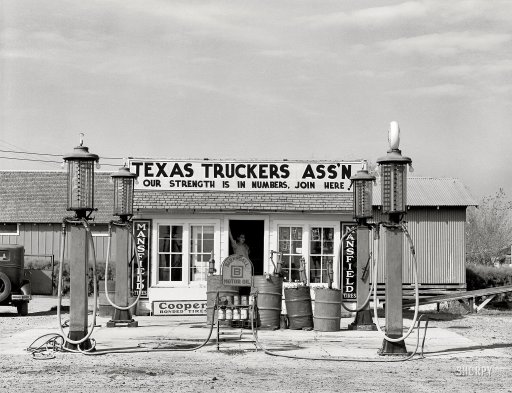Detroit Publishing Co. Milk Runner 1903 “New Orleans milk cart”
Ilargi: Thought it might be wise to insert a little warning: if you think it wise to disagree with Stoneleigh on the following essay, and we do encourage discussion, do make sure that you do come prepared. She’s an expert on this issue too. It’s very close to her heart, and will undoubtedly prove to be highly controversial. But do your homework before chiming in!
Stoneleigh: We often write, at least in the TAE comments section (link at the bottom of the page for those who have yet to find it), about elements of preparedness. One of the topics that has often sparked heated discussion is food. Since people need to be thinking about what they can grow and store, and what nutrients they need, I thought I would address the issue in an intro.
There are very many misconceptions about food, as about many other aspects of life where the received wisdom is fundamentally wrong (including our usual topic, finance). As in other cases, this institutionalized misinformation harms real people every day, yet it is almost impossible to mount a challenge from within the system because the system protects its entrenched doctrines from scrutiny.
Research is funded by vested interests (for whom the status quo is highly profitable), which shapes the questions asked and the answers obtained. Fundamental contradictions and inconvenient data are ignored. We here at TAE are contrarians in the habit of shining light in dark places, so this seems a natural place to challenge received wisdom on a new front.
I was once a biologist, hence reading through the scientific literature on nutrition was not a problem. Also, I have personally lived this particular story. I know first-hand the harm (both physical and psychological) that misinformation in this field has caused to so many people.
For those who would like vastly more detail than I intend to provide, I strongly suggest that they read Good Calories, Bad Calories by Gary Taubes. It is the most exhaustive, and simply the best nutritional review out there. The CBC Radio documentary The Heart of the Matter and the CBC TV documentary My Big Fat Diet are also very much worth your time. As it happens, the latter production highlights the important health research of a TAE reader who I have met on my travels.
In the developed world, we have seen an explosion in the incidence of the ‘diseases of civilization’ – heart disease, cancer, hypertension, chronic inflammation, diabetes and obesity. The incidence of all of these is vanishingly small in populations eating a traditional diet (or paleo-diet), but once such people arrive here, and begin consuming the same industrial food-like-substances that developed world populations eat, their incidence of morbidity of all kinds increases dramatically.
There are clearly common factors at work, which affect newcomers, and a large percentage of the population born in the developed world, but not the whole population. This is an important point to note, because our metabolisms are not all the same, as the received wisdom would have us believe. Some of us possess tolerances that others do not, and it is all too common for those who possess such tolerances to be highly critical of those who do not, and who therefore suffer the consequences of a modern lifestyle.
We are told that diet-related health problems are the result of eating too much fat and too little fibre, while doing too little exercise. We are told to limit the consumption of fat, especially saturated fat, substitute more carbohydrate and eat more fibre. If we are carrying stored mass that we are not comfortable with, we are told that we should restrict calories, especially fat, and burn off excess through exercise.
If we fail to burn off the excess in this way, we are told that we must be either greedy, or lazy, or both. Moral judgements are very common in the field of nutrition, yet these are uninformed and highly unfair.
The clearest factor showing a huge increase in consumption paralleling the increase in the incidence of the ‘diseases of civilization’ is not fat, of which paleo-diets contain substantial percentages, but sugar and other refined carbohydrates. In the developed world we commonly pump vast quantities of these cheap substances into everything we eat, especially the prepared foods that we eat so much of. Virtually all prepared foods contain large quantities of high-fructose corn syrup for instance, which is cheap thanks to financial subsidies to corn production.
We need to understand why the consumption of these substances has the dramatic effect that it does in so many people. To start with, sugar is highly addictive. Since sweet foods are so rarely poisonous in the wild, we evolved a taste for them. Since they were rare, we had no need to evolve an off-switch for them either.
Now we are surrounded by sugar in a myriad forms. Adding it to so many foods makes them more palatable, and hence more profitable. Sugar, especially fructose, disables our satiety mechanism, so that if we are eating something sweet, we tend to eat more of it without realizing that we have consumed enough.
The food industry cashes in selling us addictive foods, and then cashes in again by feeding on our insecurities about the resulting health effects, especially weight gain. As over-consumption of carbohydrates promotes a state of chronic inflammation, to which the body responds by producing cholesterol, the pharmaceutical industry can also profit by promoting cholesterol-controlling drugs. These attack the symptom, not the disease, leaving us just as prone to heart disease as before, but poorer. The status quo is highly profitable in all ways. No wonder it has been so difficult to challenge.
Our bodies exist in a life-sustaining state of homeostasis, meaning that they must maintain physical and chemical parameters within certain boundaries. One of these factors is our blood-sugar level. If our diets chronically interfere with this factor, our bodies must constantly act to bring it back under control. This means producing high levels of insulin, especially in response to a rapid spike in blood-sugar. A high level of insulin causes blood-sugar to crash and packs away the excess as fat in adipose tissue.
For many people, chronic consumption of sugar leads to chronic over-production of insulin – hyperinsulinemia, or metabolic syndrome. At this point, a carbohydrate intolerance has been developed. The person will likely gain weight, while being hungry most of the time (specifically craving sugars) and lacking in energy. Essentially, the body cells are being deprived of nutrition as the excess insulin packages away what is consumed before it can be used. The body then lowers its activity level in response to what it perceives as state of starvation.
Continuing to eat carbohydrates will have different effects depending on the person. Either the adipose tissue will develop insulin resistance (cease to be sensitive to insulin), in which case the person will eventually develop type II diabetes, or the adipose tissue remains sensitive to insulin, in which case the person continues to gain weight. Rather than being over-weight because they do little exercise, they do little exercise because the vicious circle of their diet deprives them of the energy to exercise, as well as making movement uncomfortable in extreme cases.
Some populations are much more susceptible to developing metabolic syndrome than others, with First Nations people being among the most sensitive of all. In contrast, many people from northern Europe are much less sensitive than most, and can therefore get away with consuming a modern diet without paying the same price. This is luck, not a justification for moral superiority over those with different metabolisms, but all too often the prevailing approach is unjustifiably judgmental. A modern diet simply poisons a large number of people.
Getting out of the vicious circle necessarily involves no longer eating the substances which cause insulin spikes, in other words eliminating the vast majority of carbohydrates from the diet, especially the simple sugars and refined carbohydrates. It means no bread, pasta, cereals, rice, potatoes, desserts and not too much fruit (especially very sweet fruits like apples and grapes). Since these foods are addictive, the withdrawal process will be uncomfortable, but it does not last forever. Eventually the taste for sugar disappears.
The sweetness receptors are reset, so that many things taste pleasantly sweet which did not before, and truly sweet things taste revoltingly sweet. Taking this step, and sticking to it permanently, breaks the cycle of morbidity. It keeps insulin levels under control, thereby stabilizing appetite at a much lower level. As body cells are now adequately nourished, there is energy available for exercise, and likely to be a desire to exercise as well.
Excess weight falls off in the absence of high insulin levels. In normal people, stored fat typically cycles in and out of adipose tissue. In people with metabolic syndrome, the high insulin levels make that a one-way trip in, but drastically lowering insulin levels makes it a one-way trip out, almost independent of calories consumed.
One can eat bacon and eggs, cheese, cream, vegetables and many other very satisfying foods – losing pounds without being hungry. This is a diet that is much easier to stick to than most because people who eat like this are not hungry. As it is a necessary lifetime lifestyle shift for them, this is just as well.
It is important to note that treating metabolic syndrome cannot be done on a vegan diet, as difficult as that will be for some to hear. A vegan diet is necessarily far too high in carbohydrates for those who cannot tolerate them. Vegetarianism may be possible, but would be more difficult than being an omnivore (see the book The Vegetarian Myth by Lierre Keith).
We will all need to be physically tougher than we are now in order to cope with a future that will entail much more physical activity than we are used to, hence we need to exercise and develop the necessary musculature and fitness. Those with metabolic syndrome, which is a large percentage of the population, cannot do this if they do not address the diet issues that constantly undermine their efforts. Exercise is not a major component of weight loss, but it is nevertheless essential for a healthy life.
We all need to think about what foods we have available near where we live, what we might be able to grow and what we can store. Dried carbohydrates are easy to store, so there is a temptation to concentrate on them for food storage options. Food preservation can also rely very heavily on sugar or vinegar as preserving agents.
For people with metabolic syndrome, these would be a terrible choice to make, as relying on such supplies would leave them chronically hungry and tired. We need to think about storing nutrition in traditional forms, as our ancestors would once have done (pemmican for instance), and about producing or acquiring food with the nutrients we genuinely need.
We do not need carbohydrates, but we do need proteins and fats. Proteins will be an issue for many, especially those who try to live a vegetarian or vegan lifestyle in an area with a short growing season. The further north one lives, the greater the traditional reliance on animal products. Many ecosystems require grazing animals, and these are areas that cannot easily produce food that humans could eat directly. The use of animals does not in these cases increase the human energy footprint.
What does increase the footprint in this way is feeding animals grains, which they did not evolve to eat and which therefore make them ill. We currently cope with this by feeding them large quantities of antibiotics, and destroying the effectiveness of these medicines in the process. If we are going to rely on animals for food, we must do so in a way that works with the animals’ own metabolism and with natural ecosystems. If we grass-feed cattle, for instance, we produce animals which are themselves healthier, and which are much healthier for us to consume.
Dietary fats will be a major issue going forward. We require a balance of omega 3 and omega 6 essential fatty acids, but most of us eat a diet far too high in omega 6. Consuming too much omega 6 is an additional risk factor for chronic inflammation and therefore heart disease. Animals fed on an appropriate diet for them will have the right balance of omega 3 and omega 6 fatty acids in their tissues, whereas grain-fed animals (whether beef or chickens or farmed fish) will have far too high a level of omega 6. We should also consider nut crops, although woody agriculture has its own challenges.
Providing for our own nutritional needs is going to be a major undertaking in a period where we are vastly over carrying capacity as a species. As a start, we need to stop thinking of all calories as equal, because a body is not a simple calorimeter. We are creatures with complex metabolisms, and we are not all created equal. Trying to work with own own bodies and with the ecosystems in which we live are incredibly important factors.



















